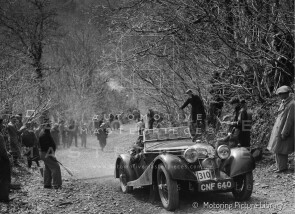
1936 Riley Sprite
ON/OFF
Why am I an Automotive Masterpiece?
L. Limited edition cars
no. 55 manufactured, 10th built
In the 1920s and 1930s, Riley established itself as a manufacturer of luxury and sports cars. The "blue diamond" brand became renowned for its technical innovations and victories in motorsport competitions. Riley cars were praised for their elegant design and dynamic performance. Despite its technical and sporting success, Riley faced economic difficulties in the 1930s due to an excessive variety of models, a limited number of shared parts, and competition from Jaguar, which influenced its strategic decisions. With stylish bodywork designed by Stanley Riley, the Coventry marque's pre-war models were among the finest small-capacity sporting cars in the world. Introduced in 1926, Percy Riley's 9hp twin-camshaft four-cylinder engine was a standout design by any standard, powering various Riley models until 1957. This twin-camshaft layout was also adopted in the new 1½-liter four-cylinder engine designed by Hugh Rose and launched in September 1934. Following the success of the "9" engine, the 12/4 or 1½ Litre became Riley's most popular engine before the war, continuing to power the RMA/E models post-war. In its Standard version, the 1.5-liter 12/4 engine produced 45/46 hp with a single Zenith carburetor. The Special Series featured twin SU carburetors and delivered 52 hp, while the top-tier Sprite specification offered 59/61 hp. Equipped with this engine, which lent it its name, the Riley 12/4 was a mid-range sedan produced by Riley from 1934 to 1935, later replaced by the 1½ Litre model. Smaller than the 15/6, it debuted with three body styles: Falcon, Kestrel, and Lynx. The range gradually expanded, with the Adelphi becoming the most popular model in subsequent years.
In 1936, the 12/4 range expanded with the introduction of the Sprite, a two-seater sports car. In its 'TT' guise, the Sprite achieved significant success, winning the Ulster Tourist Trophy in both 1935 and 1936 with Freddie Dixon at the wheel. This winning car served as the foundation for the production Sprite, unveiled at the 1935 Motor Show as a replacement for the six-cylinder MPH in Riley's lineup. Launched at a price of £425, the Sprite remained in production until 1938. The Sprite's design retained some of the racing essence of the MPH models but featured notable refinements for road use, including full fenders replacing the earlier cycle wings and various other detail changes. The rear was redesigned to accommodate the new fenders and typically housed the spare wheel. While early Sprites retained the traditional Riley radiator, the model is most often remembered for its distinctive cowled ‘fencer’s mask’ front grille. The Sprite was equipped with the 1,496cc four-cylinder overhead-valve engine from the 12/4 sedan but delivered an additional 15 hp, thanks to twin SU carburetors and tuning. Compared to the 12/4 sedan, the Sprite was lighter and more compact. It shared the underslung chassis of the six-cylinder MPHs and offered a choice between a manual gearbox or the advanced Wilson pre-selector transmission. Despite their shared heritage, the Sprite and MPH differed significantly in appearance, a distinction often overlooked. Sporty and elegant, the Sprite boasted a top speed of 141 km/h. Writing in The Sports Car in 1957, John Stamford praised the model, stating, “The best of the series was the Sprite, which... had a distinctly lively performance up to its maximum of nearly 90mph...” The Sprite earned accolades for its racing achievements, including victories at the 1936 Tourist Trophy and the French Grand Prix. Notably, after World War II, it became the car of choice for Mike Hawthorn's early racing successes. Despite its achievements, the Sprite was discontinued without a direct successor. As Riley's final factory-produced sports car, the Sprite has retained its popularity over time. Of the 55 units believed to have been built, 19 examples are known to exist today.
The Riley Sprite, chassis no. S26S4394, contributed to the celebrated sporting reputation of this model. Produced on July 16, 1936, and registered in UK with CNF 640 plates, its first recorded owner in 1937 was British racing driver T. S. Heaton-Fairclough, who competed with the car in events such as the M.C.C. Sporting Trial and M.C.C. Edinburgh Trial in 1937, as well as the M.C.C. Lands’ End Trial in 1939. He retained ownership until 1945, after which E. B. Kay acquired the car in 1947. Kay also campaigned the car in various competitions with notable success, including a victory in the 1947 Berkhamsted & D.M.C & C.C. Bossingham Cup Trial, where he won the “Cup for Best Performance.” In 1949, the car achieved 2nd overall and 1st in class in both the M.C.C. Lands’ End Trial and M.C.C. Edinburgh Trial. Kay is believed to have owned the car until the mid-1970s. In 1976, chassis no. S26S4394 entered the collection of car enthusiast John Thomas Golder and returned to competition in events organized by the Vintage Sports-Car Club. Golder owned the Riley until 2003, when it was purchased by Swiss actor Klaus Wildbolz, a prominent figure in German-language television series and a regular participant in historic car racing alongside his twin brother. In 2011, Wildbolz sold the car to Italian collector Bruno Marini, who undertook extensive mechanical work, including rebuilding the engine. The Riley received FIA and FIVA passes and was prepared for competition, while its exterior and interior were left untouched to preserve its authentic "patina." Under Marini's ownership, the car successfully competed in five editions of the Mille Miglia reenactment from 2012 to 2016. In 2018, chassis no. S26S4394 changed hands again, this time to a Belgian owner who continued its Mille Miglia legacy by participating in the 2018 and 2019 editions of the event. It was therefore featured in the book Mille Miglia's Chassis Volume I, by Sandro Binelli, published by Automotive Masterpieces.





